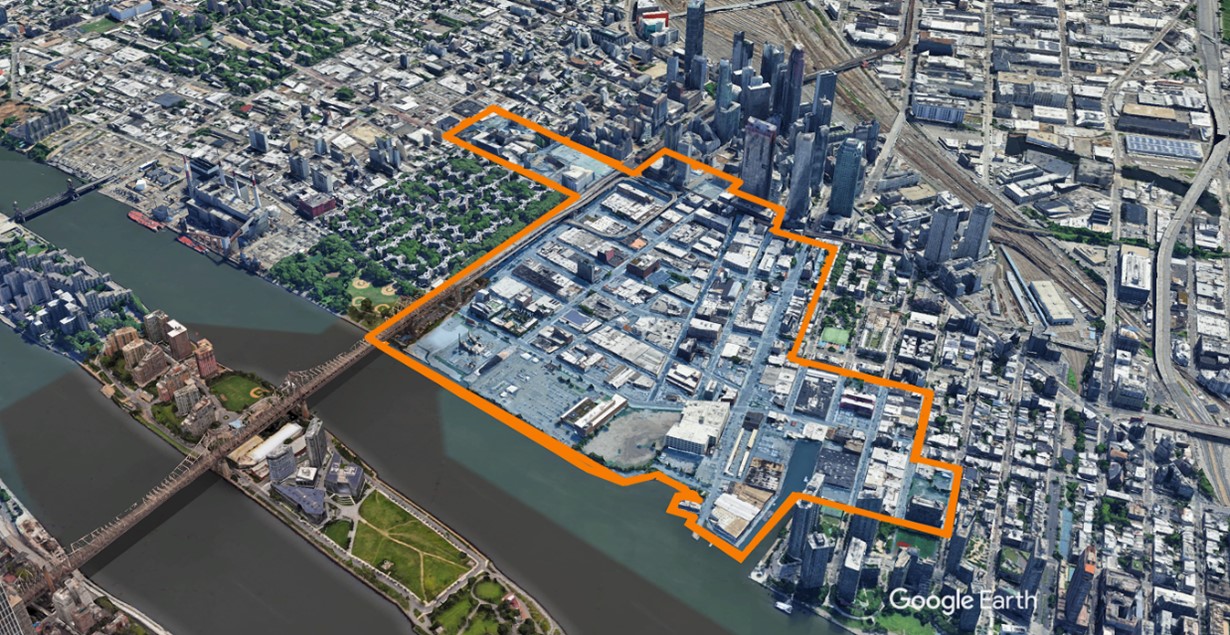Secondary Navigation
Mayor Adams Kicks Off Public Review on OneLIC Neighborhood Plan to Create Nearly 15,000 Homes and Over 14,000 Jobs, Transform Waterfront Access in Long Island City
April 21, 2025
Building on Nearly Two Years of Extensive Community Engagement, Plan Would Revitalize Zoning and Require New Developments to Include Permanently Affordable Housing
Plan Would Create Over 3.5 Million Square Feet of Commercial and Industrial Space
Fifth Neighborhood Plan to Start Public Review Under Adams Administration,
OneLIC Highlights New York City’s Continued Commitment to Transformative Housing Projects
NEW YORK – New York City Mayor Eric Adams and New York City Department of City Planning (DCP) Director and City Planning Commission (CPC) Chair Dan Garodnick today announced the start of the public review process for the OneLIC Neighborhood Plan, an ambitious proposal to deliver tens of thousands of homes and jobs to Long Island City, Queens. This initiative would revamp local zoning and map Mandatory Inclusionary Housing — which requires new developments to include permanently affordable housing — on a wide scale in the neighborhood for the first time, creating nearly 14,700 new homes. Finally, the plan would increase commercial and industrial space in the area, creating 14,400 new jobs and bolstering economic opportunities for residents, workers, and business owners alike. OneLIC is the Adams administration’s fifth neighborhood plan to enter the public review process. If this plan were to be adopted, the Adams administration’s five neighborhood plans would deliver more than 50,000 housing units to New Yorkers over the next 15 years.

OneLIC Neighborhood Plan would transform Long Island City with thousands of new homes and jobs, creating a more affordable neighborhood for New Yorkers. Image Credit: DCP.
“In order to make New York City the best place to raise a family, we need more affordable homes and more good-paying jobs, and the OneLIC Neighborhood Plan will help create both,” said Mayor Adams. “Whether it’s advancing our neighborhood plans, building record amounts of new homes, or passing our historic ‘City of Yes for Housing Opportunity’ initiative, no administration has done more to tackle New York City’s housing crisis than we have over the last three years.”
“The Adams administration is committed to improving the lives of New Yorkers by creating a record-breaking number of homes in Long Island City,” said Deputy Mayor for Housing, Economic Development, and Workforce Adolfo Carrion, Jr. “The OneLIC plan will bring an additional 14,700 homes — the most the city has done in a neighborhood plan in over two decades — and 3.5 million square feet of commercial space. We are committed to investing in schools, parks, and a new waterfront esplanade to create a strong, vibrant, and inclusive neighborhood. Thanks to Councilmember Won for her engagement in the planning process and her commitment to ensure this neighborhood plan’s success.”
“With its central location, great transit access, and diverse economic base, Long Island City is exactly the kind of place where we should add new homes,” said DCP Director and CPC Chair Garodnick. “This plan updates zoning in parts of the neighborhood still limited by outdated and restrictive rules, allowing more housing and jobs while creating a more accessible and resilient waterfront. These thoughtful changes, along with significant neighborhood investments, can set Long Island City on the path towards a more affordable, equitable, and prosperous future.”
“The OneLIC plan will bring thousands of new homes, commercial space, and neighborhood amenities to a part of the city where new development has been long-envisioned but never materialized,” said New York City Executive Director for Housing Leila Bozorg. “Today's milestone comes after many months of engagement with the community and local stakeholders who have helped inform a wide array of investments that will support this new development. I look forward to seeing this plan get refined and strengthened through the public review process.”
Long Island City is a fast-growing economic and cultural hub with easy access to transit, housing, and commercial and industrial job opportunities. In recent years, parts of this neighborhood have welcomed thousands of residents, businesses, and public waterfront space. In other areas, however, outdated zoning rules have restricted new housing while significant sections of the waterfront have remained inaccessible to the public. The OneLIC Neighborhood Plan is designed to address these challenges.
The plan’s boundaries stretch from the East River waterfront to Crescent Street and Queens Plaza North to 47th Avenue, with one segment reaching further up to 39th Avenue between 21st Street to 23rd Street.

OneLIC Neighborhood Plan will update outdated zoning and expand access to the waterfront. Image Credit: DCP.
Building More Affordable Homes
The start of public review on the OneLIC Neighborhood Plan is a significant milestone towards creating a more affordable and equitable Long Island City for working-class families. Today, around 46 percent of renters in the neighborhood spend more than 30 percent of their income on rent, and current zoning does not require permanently-affordable, income-restricted homes.
The OneLIC plan would provide more housing opportunities across the neighborhood and apply Mandatory Inclusionary Housing to Long Island City, for the first time. By requiring new developments in Long Island City to include permanently affordable housing, Mandatory Inclusionary Housing is expected to produce roughly 4,000 income-restricted homes, enough to house roughly 10,000 New Yorkers. Additionally, the plan will use city-owned sites to create homes for lower-income households; for instance, at 44-59 45th Avenue, where the city currently houses New York City Department of Transportation operations, the Adams administration has committed to building 320 income-restricted homes.
To protect tenants and preserve existing affordable housing, the city will partner with community-based organizations and local elected officials to organize trainings and events around tenants’ issues, such as “Know Your Rights” classes and housing resource fairs. Homeowners would have access to the Homeowner Help Desk, which provides counseling, financial assistance, and more, as well as HomeFix 2.0, which connects New Yorkers with low- or no-interest home repair loans.
Creating an Accessible Waterfront
Despite Long Island City’s extensive waterfront, public access has, in the past, been disjointed and, in some cases, restricted entirely. The OneLIC Neighborhood Plan would coordinate public and private property owners, update the area’s Waterfront Access Plan, and use additional zoning tools to create a unified, resilient waterfront with improved public access and amenities. This improvement would create vibrant public spaces by incentivizing active street-level uses and active recreation spaces, creating a consistent public space for the neighborhood, and unifying the waterfront from Gantry Plaza State Park to Queensbridge Park.

OneLIC Neighborhood Plan would unify the waterfront from Gantry Plaza State Park to Queensbridge Park, creating a consistent public space for the neighborhood. Image Credit: DCP.
Supporting More Jobs and Stronger Infrastructure
The OneLIC Plan would also grow the local economy by creating over 3.5 million square feet of commercial and industrial space, generating approximately 14,400 new jobs across a range of sectors. To further support Long Island City residents and workers, the New York City Economic Development Corporation (NYCEDC) is pursuing a Request for Expressions of Interest for 44-36 Vernon Boulevard, looking for concepts to transform this city-owned site, which currently houses New York City Department of Education operations, into a mix of community-focused uses that could include commercial, cultural, industrial, retail, and more. The administration will continue to coordinate with other city agencies, New York City Councilmember Julie Won, and the Long Island City community to find other opportunities for investment during public review, to ensure that the Adams administration is meeting the needs of current and future residents.
Engaging with the Community
The OneLIC Neighborhood Plan reflects the priorities of neighborhood residents and stakeholders, incorporating feedback from a two-year public engagement process that included 15 public meetings (both in-person and online) with a grand total of 1,600 participants. DCP also received over 5,700 comments and 2,350 survey responses from New Yorkers about the proposal. Alongside today’s certification, DCP has also published the OneLIC Neighborhood Plan booklet, which provides detailed information on the proposal, planning process, and next steps.
In addition to the close collaboration with Councilmember Won, DCP worked closely with many community stakeholders, including the New York City Housing Authority (NYCHA) Queensbridge Houses Tenant Associations, the Long Island City Partnership, Queens Community Board 1 and 2, Queens Public Library, Jacob Riis Community Center, Renewable Ravenswood, and Hunters Point Park Conservancy.
The OneLIC Neighborhood Plan now begins the roughly seven-month Uniform Land Use Review Procedure, which includes reviews by Queens Community Boards 1 and 2 and Queens Borough President Donovan Richards, followed by hearings and binding votes at the CPC and then in the New York City Council.
“After 18 months of extensive public engagement, which shaped our community priorities, I am energized to enter certification and negotiations for OneLIC. I will fight to ensure the final OneLIC Neighborhood Plan delivers resiliency, sustainability, and longevity, through commitments on deeply affordable housing, pathways to affordable home ownership, thousands of additional school seats, a connected waterfront, new green spaces, and more,” said New York City Councilmember Julie Won. “Save the date: May 21st — come testify at the community board’s special hearing on the OneLIC project at LaGuardia Community College.”
“Hunters Point Parks Conservancy has worked for 26 years to support the waterfront parks in Long Island City. We're excited that OneLIC will help expand green spaces along the water and help increase the number of parks in our community, as the lack of parks in District 26 means our current spaces are increasingly crowded,” said Jessica Sechrist, executive director, Hunters Point Parks Conservancy. “We appreciate the work Councilmember Won, the New York City Department of City Planning, and the consultants have done to ensure the community is heard and our needs are met throughout this process, and we look forward to seeing a coherent plan for the future of Long Island City be put into practice.”
“The OneLIC neighborhood plan is a thoughtful and necessary step toward ensuring that Long Island City continues to thrive as the most mixed-use neighborhood in New York City,” said Laura Rothrock, president, Long Island City Partnership. “With Long Island City at the geographic center of the city, and as a hub where jobs, housing, industry, arts, culture, and community all intersect, we need zoning that reflects our current reality and supports our continued growth. We commend the city, the New York City Department of City Planning, and Councilmember Julie Won for working collaboratively on this process, and we especially appreciate the emphasis on public engagement throughout.”
“The Long Island City rezoning is a powerful example of how 485-x can deliver both urgently needed housing and real middle-class career opportunities for union construction workers,” said Gary LaBarbera, president, Building & Construction Trades Council of Greater New York. "With an estimated 14,000 new homes — including permanently affordable housing — and some 10,000 union construction opportunities, this plan represents a bold step toward a stronger, more equitable city. We applaud Councilmember Julie Won and the mayor for advancing a neighborhood plan that will produce more housing than any in recent memory and look forward to building a better Long Island City."
“This rezoning is a rare opportunity to make Long Island City truly cohesive, if we get it right. Thoughtful development includes a responsibility to honor the culture, people, and creativity that made Long Island City what it is. Artists, residents, businesses, and developers must work together to build a neighborhood that doesn’t just grow, but thrives,” said Edjo Wheeler, executive director, Culture Lab LIC. “Councilmember Julie Won did a great job ensuring the entire community had a voice in this process, and now we have a real chance to show how thoughtful planning can strengthen — not displace — a neighborhood. If we get this right, Long Island City becomes a model for how growth and equity can coexist.”
"Neighborhood plans that meaningfully add new homes are among the most powerful tools the city has to address the housing shortage — and that's exactly the potential we see in OneLIC," said Annemarie Gray, executive director, Open New York. "For too long, a well-housed minority has dominated the housing conversation and stood in the way of the homes New Yorkers desperately need. We’re excited to be part of the public review process launched today to ensure that decision-makers hear from the many New Yorkers who support building a more affordable and inclusive city."
The Adams Administration’s Record on Housing
This year, Mayor Adams has doubled down on his commitment to build more affordable housing across the five boroughs. Earlier this year, Mayor Adams and the NYCEDC announced the next phase of an ambitious, bold new vision for Coney Island in Brooklyn that will deliver 1,500 new homes and invest in the reconstruction of the historic Riegelmann Boardwalk. Additionally, Mayor Adams and the New York City Department of Housing Preservation and Development (HPD) celebrated a $82 million investment to put homeownership within reach for more New Yorkers by expanding the HomeFirst Down Payment Assistance Program. Finally, the Adams administration has advanced several bold, forward-looking projects, including reimagining Gansevoort Square to build mixed-income housing, building 100 percent affordable housing at the Grand Concourse Library in the Bronx, advancing the 388 Hudson development in Manhattan to provide hundreds of critically-needed affordable housing units, and kicking off public review on the Midtown South Mixed-Use plan to create nearly 10,000 homes — all building on this year’s State of the City address.
Since entering office, Mayor Adams had made historic investments toward creating affordable housing and ensuring more New Yorkers have a place to call home. DCP is advancing several robust neighborhood plans that, if adopted, would deliver more than 50,000 units over the next 15 years. In addition to the OneLIC plan, DCP is advancing plans in Midtown South in Manhattan and Jamaica in Queens. Last month, the CPC voted in favor of the Atlantic Avenue Neighborhood Plan. Last year, the City Council approved the Bronx-Metro North Station Area Plan, which will create approximately 7,000 homes and 10,000 permanent jobs in the East Bronx.
Moreover, last December, Mayor Adams celebrated the passage of “City of Yes for Housing Opportunity,” the most pro-housing proposal in city history that will build 80,000 new homes over 15 years and invest $5 billion towards critical infrastructure updates and housing. In June 2024, City Hall and the New York City Council agreed to an on-time, balanced, and fiscally-responsible $112.4 billion Fiscal Year (FY) 2025 Adopted Budget that invested $2 billion in capital funds across FY25 and FY26 to HPD and NYCHA’s capital budgets. In total, the Adams administration has committed $24.5 billion in housing capital in the current 10-year plan as the city faces a generational housing crisis. Mayor Adams celebrated back-to-back record breaking fiscal years, as well as back-to-back calendar years in both creating and connecting New Yorkers to affordable housing. Last spring, the city celebrated the largest 100 percent affordable housing project in 40 years with the Willets Point transformation.
Further, the Adams administration is using every tool available to address the city's housing crisis. Mayor Adams announced multiple new tools, including a $4 million state grant, to help New York City homeowners create accessory dwelling units that will not only help older adults afford to remain in the communities they call home but also help build generational wealth.
In addition to creating more housing opportunities, the Adams administration is actively working to strengthen tenant protections and support homeowners. The Partners in Preservation Program was expanded citywide in 2024 through an $11 million investment in local organizations to support tenant organizing and combat harassment in rent-regulated housing. The Homeowner Help Desk, a trusted one-stop shop for low-income homeowners to receive financial and legal counseling from local organizations, was also expanded citywide in 2024 with a $9.85 million funding commitment.
Finally, Mayor Adams and members of his administration successfully advocated for new tools in the 2024 New York state budget that will spur the creation of urgently needed housing. These tools include a new tax incentive for multifamily rental construction, a tax incentive program to encourage office conversions to create more affordable units, lifting the arbitrary "floor-to-area ratio" cap that held back affordable housing production in certain high-demand areas of the city, and the ability to create a pilot program to legalize and make safe basement apartments.
Media Contact
pressoffice@cityhall.nyc.gov
(212) 788-2958

